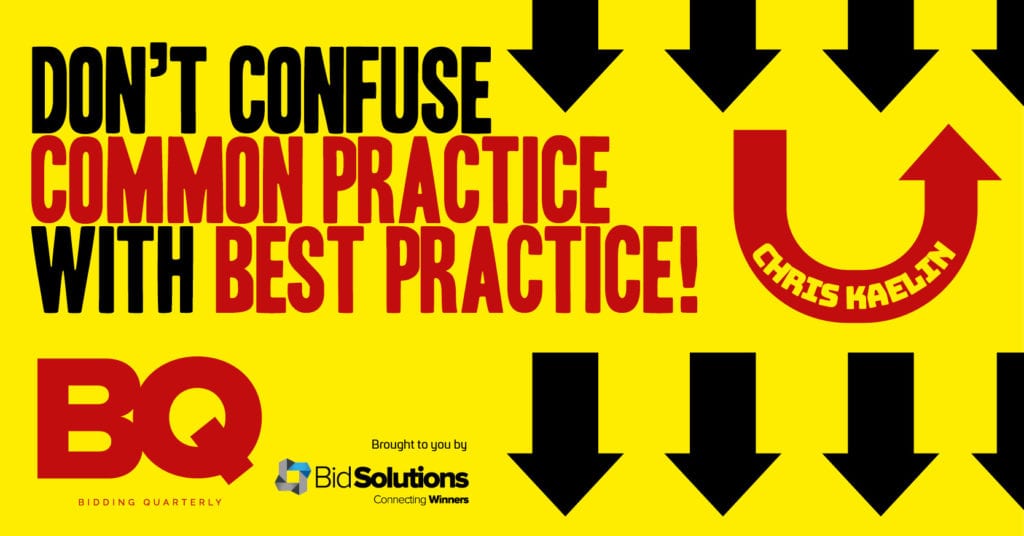
Much of what we have thus far taken for granted has come to a grinding halt in the past year. Now is the perfect time to actively re-think your standard operating procedures and re-assess your practices after the lockdown. You might think: “Why? This is how everyone does it!” Oh dear. Or even worse: “This is how we have always done it!” Of course, when everyone does it ‘this’ way, it can’t be wrong; it must be ‘best practice’. Nooooooo!
In principle, best practice is always the ‘best’ approach according to today’s standards. However, clearly identifying which approach is ‘best’ sometimes comes down to a matter of opinion.
Many people get ‘best practice’ mixed up with ‘common practice’. For example, if practically all companies were using Microsoft PowerPoint®, with lots of bullet points for their proposal presentations, it would be classed as common practice. Everyone does the same thing because it’s within their comfort zones. But the fact that everyone does it this way does not mean that it’s the best practice. There are better alternatives to a marathon of dull slides. This is NOT best practice!
In general, best practice is often a matter of healthy common sense rather than a complicated science. This is also the case in bid and proposal management. There are plenty of things we know but still don’t put into practice; we don’t think to do so or just don’t have the time or inclination. In this case, it makes sense to stop, think about it and plan a new strategy.
Specifically, we want our proposal document stand out because the ‘average’ common practice proposal only has random chances of winning the deal.
“The issue is we usually don’t like leaving our comfort zone. And oh boy, are there many comfort zones in bid and proposal management! But so often, once we have chosen to enter new territories, we realise how easy it was and how much we have achieved with a tiny little effort!”
So, get out of your comfort zone! Six simple examples:
1) ‘Proposal’
It starts with the title. How many submissions have the meaningless and dull title ‘Proposal’ instead of ‘Increasing ABC’s productivity with [bidder’s] state-of-the-art collaboration tools’?
2) “Thank you for providing us with the opportunity to make a proposal.”
Not really the most exciting option for starting an executive summary, right? Yawn. Dull. Just drop this.
3) “You are important to us.”
Sure, customers are important as they mean business for you. But your customer doesn’t care about this. Drop it. Horrible marketing twaddle.
4) ‘Fig. 3.2: Solution Architecture’
Solution Architecture! How exciting. Instead write something that is beneficial to your client, such as ‘Fig. 3.2: The solution is fully redundant, leading to an availability of 99.98%, ensuring ABC will deliver their services without interruption’.
5) ‘You’ instead of ‘Us’: Customer orientation on its simplest level
Say “You will receive…” instead of “We will provide…”.
Say “You will benefit from our solution by…” instead of “Our solution can…”.
Say “Your organisation will be able to…” instead of “Our company is…”.
6) “If you like our proposal, we are looking forward to hearing from you.”
Sure. This would be nice. However, if we were really interested in this customer, it would be our job to follow-up with them, not vice versa. This is called ‘selling’. Those times where we can simply wait for orders are definitely over.
Yes, you can do it!
You have certainly recognised that getting out of the comfort zone can be quite simple and also very effective. In these crazy times where people no longer conform to the 9-5 (particularly after last year, which felt like a time warp in so many ways), this might be the perfect occasion to also re-think your ‘standard operating procedures’ (common practices).
Don’t confuse common practice with best practice!
This article was written by Christopher Kaelin.
Chris is a global authority on bid and proposal management. He was co-founder and chairman of the German-speaking APMP chapter and regional director for Europe/Africa. He is APMP-certified at Professional Level (CPP APMP) and is an APMP Approved Trainer. In 2013, he received the prestigious Fellows Award.

